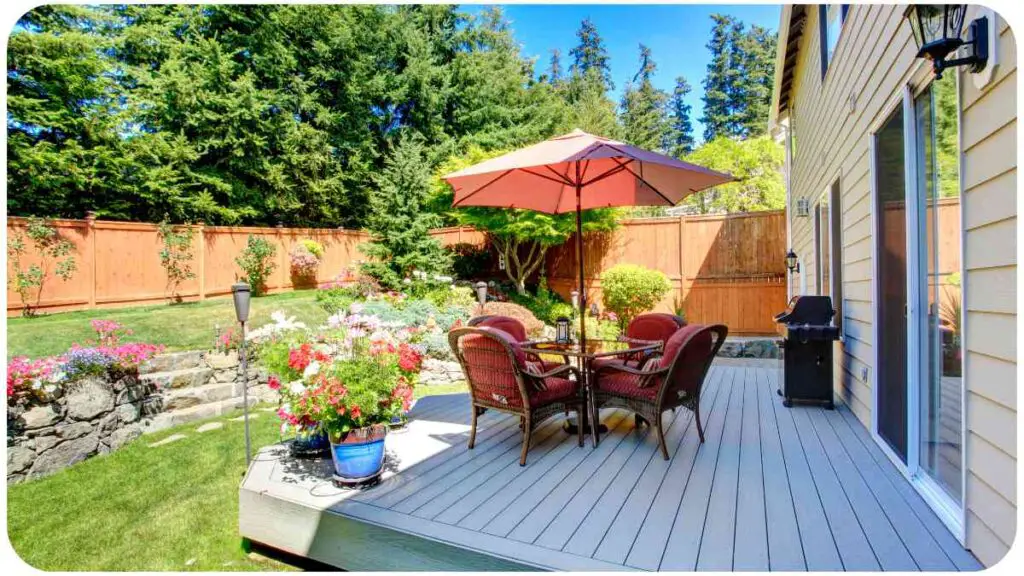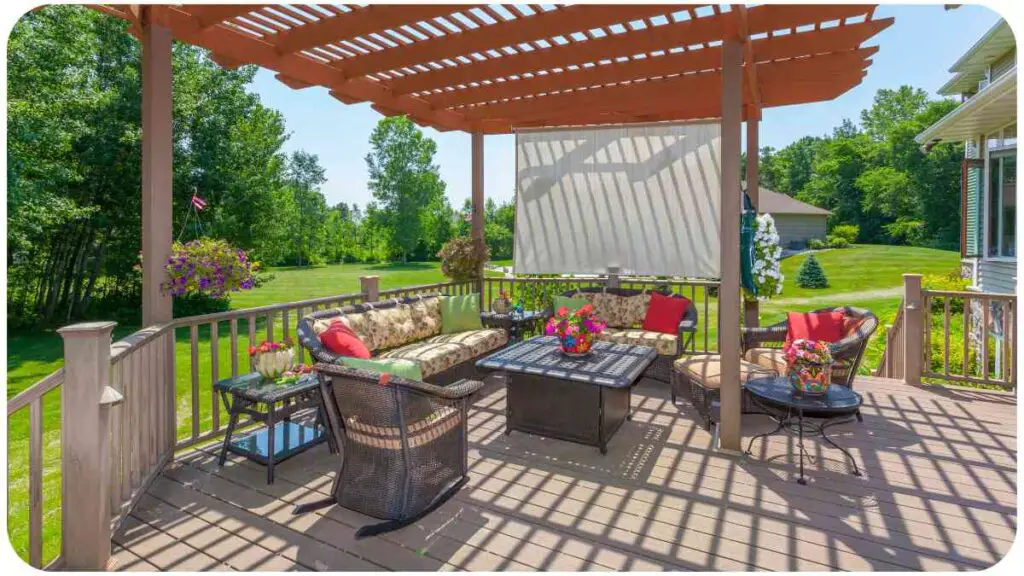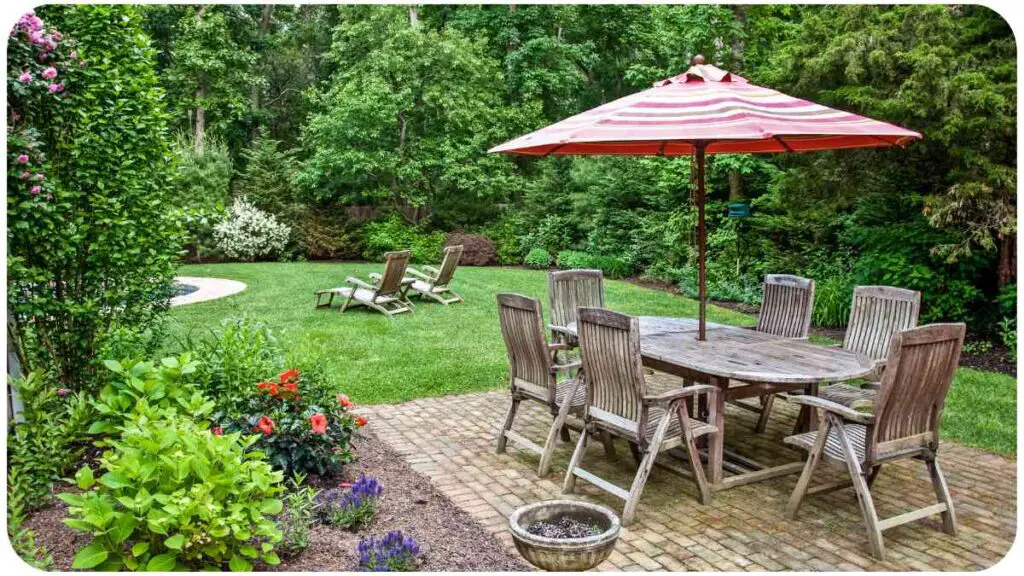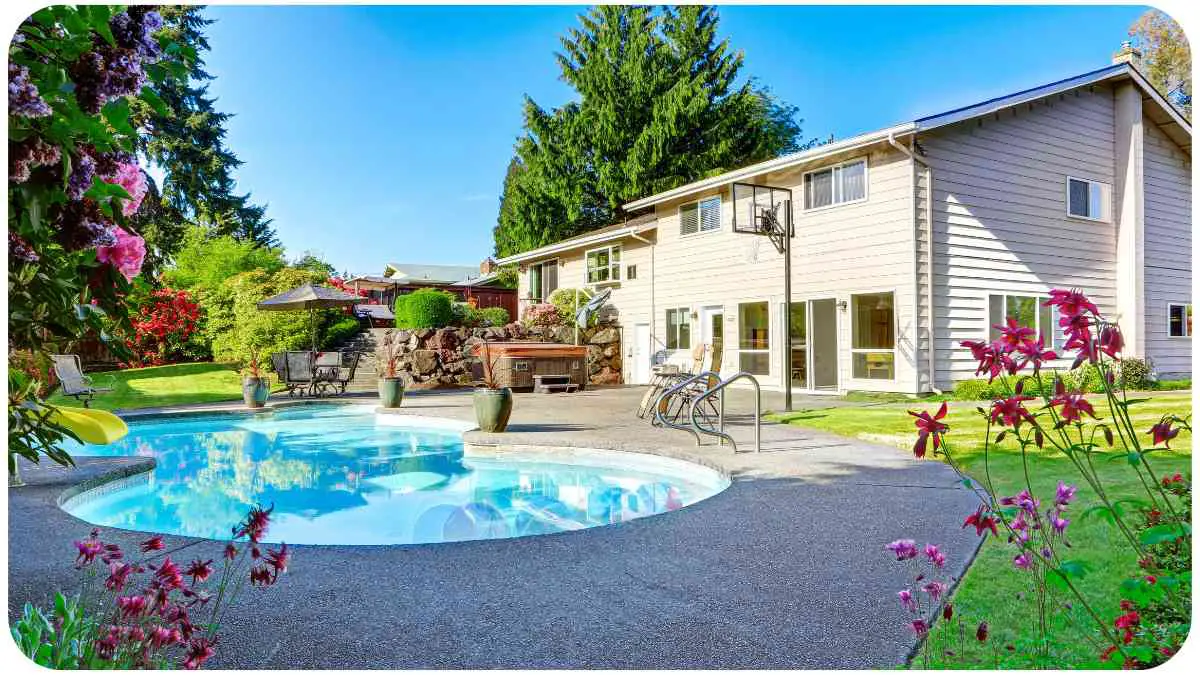In today’s fast-paced world, finding a moment of peace and tranquility can be challenging. Many of us seek an escape from the constant hustle and bustle, yearning for a place to unwind and connect with nature.
What if I told you that this sanctuary could be just a few steps away, right in your backyard? Creating a backyard sanctuary offers a serene retreat from the daily grind, allowing you to recharge and enjoy the beauty of nature without leaving your home.
| Takeaways |
|---|
| Creating a backyard sanctuary offers a peaceful retreat from the daily grind. |
| Spending time in a backyard sanctuary can reduce stress, anxiety, and depression. |
| Gardening provides physical benefits, such as improved strength and flexibility. |
| Native plants and sustainable practices support local wildlife and the environment. |
| Comfortable seating areas and water features enhance relaxation and enjoyment. |
| Bird feeders, pollinator gardens, and shelters can attract diverse wildlife. |
| Water conservation, composting, and using native plants make your sanctuary eco-friendly. |
| DIY projects like building benches, creating pathways, and making birdbaths add personal touches. |
| Regular maintenance, including seasonal care, pest management, and pruning, keeps your sanctuary thriving. |
| Family-friendly features like kids’ play areas, outdoor dining spaces, and interactive gardens enhance usability. |
| Recycling, upcycling, smart shopping, and DIY decor can help create a budget-friendly sanctuary. |
| Incorporating technology, such as outdoor lighting and automated irrigation, can improve convenience. |
| Personalizing your sanctuary with art, customized furniture, and themed gardens makes it uniquely yours. |
| Overcoming challenges like limited space, tight budgets, and environmental concerns is possible with creativity and resourcefulness. |
| Case studies show the successful transformation of backyards into relaxing, wildlife-friendly, and family-centric sanctuaries. |
Benefits of a Backyard Sanctuary

Mental Health Benefits
A backyard sanctuary can be a haven for mental well-being. The simple act of spending time outdoors, surrounded by greenery and natural elements, has been shown to reduce stress, anxiety, and depression. Imagine coming home after a long day and stepping into your private oasis, where the worries of the day melt away.
Transform your limited space into lush greenery with tower and wall gardens. These innovative solutions offer vertical growth opportunities, maximizing space while enhancing your outdoor oasis.
Physical Health Benefits
Beyond mental health, backyard sanctuaries contribute to physical well-being. Gardening, for instance, is an excellent form of exercise, providing cardiovascular benefits, improving strength, and enhancing flexibility. Whether you’re planting flowers, pruning shrubs, or simply enjoying the fresh air, your body reaps the rewards.
Environmental Benefits
Creating a backyard sanctuary also has significant environmental benefits. By incorporating native plants and sustainable practices, you can create a habitat for local wildlife, support pollinators, and contribute to the overall health of your ecosystem. Your backyard can become a thriving mini-ecosystem, playing a small but vital role in environmental conservation.
Planning Your Backyard Sanctuary
Assessing Your Space
The first step in creating your backyard sanctuary is assessing the space you have. Take note of the size, layout, and existing features of your yard. Consider the amount of sunlight, shade, and wind exposure different areas receive. This information will help you decide what plants and features will thrive in your sanctuary.
Craft your personal haven by transforming your patio into a serene retreat. Embrace the tranquility of nature in your outdoor space, where relaxation meets elegant design, fostering moments of solace and rejuvenation.
Setting Goals
Next, set clear goals for your backyard sanctuary. Are you looking to create a space for relaxation, a playground for children, or a haven for wildlife? Defining your objectives will guide your design choices and ensure that your sanctuary meets your needs and desires.
Design Elements of a Backyard Sanctuary

Choosing the Right Plants
Selecting the right plants is crucial for a successful backyard sanctuary. Opt for a mix of perennials, annuals, shrubs, and trees that suit your climate and soil conditions. Consider plants that provide color, texture, and fragrance throughout the year. Native plants are often the best choice as they are adapted to your local environment and require less maintenance.
Creating Seating Areas
Comfortable seating areas are essential for enjoying your sanctuary. Whether it’s a cozy bench under a tree, a hammock swaying in the breeze, or a set of outdoor furniture on a patio, ensure there are inviting spots to sit, relax, and take in the surroundings.
Incorporating Water Features
Water features, such as fountains, ponds, or birdbaths, add a soothing element to your backyard sanctuary. The sound of trickling water can create a calming atmosphere, while a pond can attract wildlife like birds and frogs, enhancing the natural beauty of your space.
Discover hidden corners of peace in your outdoor haven with cozy nooks designed for reading and relaxation. Escape the chaos of everyday life and immerse yourself in the serenity of nature, enveloped in comfort and solitude.
Wildlife-Friendly Features
Bird Feeders and Houses
Invite feathered friends into your sanctuary by installing bird feeders and houses. Different types of feeders attract various bird species, providing endless enjoyment as you watch them flit about. Birdhouses offer nesting sites, encouraging birds to make your backyard their home.
Pollinator Gardens
Pollinator gardens are designed to attract bees, butterflies, and other pollinating insects. By planting a variety of nectar-rich flowers, you can support these essential creatures and enjoy the added beauty they bring to your garden.
Providing Shelter
Create safe havens for wildlife by providing shelter options such as hedges, brush piles, and log piles. These features offer protection from predators and harsh weather, encouraging more wildlife to visit and stay in your sanctuary.
Sustainable Practices for Your Sanctuary
Water Conservation
Implementing water conservation techniques is essential for a sustainable backyard sanctuary. Use rain barrels to collect and store rainwater for irrigation, and opt for drought-tolerant plants that require less watering. Mulching around plants helps retain moisture and reduces water usage.
Elevate your outdoor gatherings to unforgettable experiences by embracing outdoor entertaining. Create magical moments under the open sky, surrounded by lush greenery and the laughter of loved ones, making memories that last a lifetime.
Composting
Composting is an excellent way to recycle kitchen scraps and yard waste into nutrient-rich soil. Create a compost bin in your backyard to produce your own organic fertilizer, reducing the need for chemical fertilizers and enriching your garden soil.
Using Native Plants
Native plants are well-suited to your local environment, requiring less water, fertilizer, and pesticides. They provide habitat and food for local wildlife, making your backyard sanctuary more sustainable and eco-friendly.
DIY Projects for Your Backyard Sanctuary
Building a Garden Bench
A garden bench provides a perfect spot to sit and enjoy your sanctuary. Building one yourself can be a rewarding project. Choose weather-resistant wood and follow a simple design plan to create a sturdy and comfortable bench.
Creating a Pathway
Pathways guide visitors through your sanctuary and protect delicate plants from foot traffic. Use materials like gravel, stones, or wood chips to create attractive and functional paths that complement your garden design.
Craft a peaceful sanctuary in your backyard, creating a tranquil retreat where serenity reigns supreme. Embrace the soothing ambiance of nature, designed to calm the mind and invigorate the soul, offering respite from the hustle and bustle of daily life.
Making a Birdbath
Birdbaths are a great addition to any backyard sanctuary. You can make a simple birdbath using a shallow dish, pedestal, and some decorative stones. Place it in a shady spot and keep it filled with fresh water to attract birds.
Maintaining Your Backyard Sanctuary

Seasonal Care
Each season brings different tasks for maintaining your backyard sanctuary. In spring, focus on planting and mulching. Summer requires regular watering and weeding. Fall is the time for pruning and preparing for winter, while winter involves protecting plants and structures from the cold.
Pest Management
Managing pests is crucial to keeping your sanctuary healthy. Use natural pest control methods, such as introducing beneficial insects, using organic sprays, and planting pest-resistant varieties. Regularly inspect your plants for signs of pests and take action promptly.
Pruning and Weeding
Regular pruning and weeding keep your garden looking tidy and healthy. Prune dead or overgrown branches to promote growth and remove weeds to prevent them from competing with your plants for nutrients and water.
Family-Friendly Backyard Sanctuary Ideas
Kids’ Play Areas
Incorporate play areas for children in your backyard sanctuary. A sandbox, swing set, or treehouse can provide hours of entertainment while blending seamlessly with the natural surroundings.
Outdoor Dining Spaces
Create an outdoor dining space where your family can enjoy meals together in the fresh air. A sturdy table and chairs, along with some shade from an umbrella or pergola, can turn your backyard into an alfresco dining room.
Interactive Gardens
Interactive gardens, such as vegetable patches or sensory gardens, engage children and adults alike. Growing vegetables teaches kids about nature and healthy eating, while sensory gardens offer a multi-sensory experience with plants that appeal to touch, smell, and sight.
Budget-Friendly Tips
Recycling and Upcycling
Recycling and upcycling materials can save money and add unique charm to your sanctuary. Use old pallets to build garden furniture, repurpose glass jars as lanterns, or transform an old ladder into a plant stand.
Smart Shopping
Shop smart by looking for sales, discounts, and second-hand items. Nurseries often have end-of-season sales where you can find plants at reduced prices. Online marketplaces and garage sales are great places to find affordable garden decor and tools.
DIY Decor
Create your own garden decor to personalize your sanctuary without breaking the bank. Paint rocks to use as garden markers, make wind chimes from recycled materials, or craft a mosaic stepping stone.
Incorporating Technology
Outdoor Lighting
Outdoor lighting extends the usability of your backyard sanctuary into the evening hours. Solar-powered lights are an eco-friendly option, providing ambient lighting along pathways, around seating areas, and highlighting garden features.
Automated Irrigation Systems
An automated irrigation system ensures your plants receive consistent watering, saving you time and conserving water. Drip irrigation systems are particularly efficient, delivering water directly to the plant roots with minimal waste.
Smart Garden Gadgets
Smart garden gadgets, such as soil moisture sensors, weather stations, and plant monitors, can help you maintain your sanctuary with ease. These devices provide valuable data and reminders to keep your garden thriving.
Personalizing Your Sanctuary
Adding Art and Sculptures
Art and sculptures add personality and charm to your backyard sanctuary. Choose pieces that reflect your style, whether it’s whimsical garden gnomes, elegant statues, or DIY art projects.
Customizing Furniture
Customize your garden furniture with cushions, pillows, and throws that reflect your taste and add comfort. Consider painting or staining wooden furniture to match your garden’s color scheme.
Themed Gardens
Create themed gardens to express your interests and passions. Whether it’s a Zen garden, a butterfly garden, or a fairy garden, themed spaces add a unique touch to your sanctuary.
Case Studies and Success Stories
Transforming a Small Urban Yard
Jane, a city dweller, transformed her small urban yard into a lush sanctuary by using vertical gardening techniques and container plants. Despite limited space, she created a vibrant, green retreat that serves as a perfect escape from city life.
Creating a Wildlife Haven
Tom and Lisa turned their suburban backyard into a wildlife haven by planting native species, installing bird feeders, and creating a small pond. Their sanctuary now attracts a variety of birds, butterflies, and even small mammals, providing endless enjoyment and a sense of connection to nature.
Family-Centric Sanctuaries
The Johnson family designed their backyard sanctuary with family fun in mind. They incorporated a play area for their kids, a vegetable garden for family gardening sessions, and a cozy seating area for outdoor family dinners. Their sanctuary has become a central part of their daily lives, bringing the family closer together.
Challenges and How to Overcome Them
Dealing with Limited Space
Limited space can be a challenge, but with creative solutions like vertical gardening, container planting, and multi-purpose furniture, you can maximize every inch of your backyard sanctuary.
Managing a Tight Budget
Creating a backyard sanctuary on a tight budget requires smart planning and resourcefulness. Focus on essential elements first, use recycled materials, and take advantage of sales and DIY projects to keep costs down.
Addressing Environmental Concerns
Environmental concerns, such as water scarcity and pollution, can impact your sanctuary. Use sustainable practices like rainwater harvesting, composting, and organic gardening to create an eco-friendly space.
Conclusion
A backyard sanctuary offers a peaceful retreat from the daily grind, providing numerous benefits for your mental, physical, and environmental well-being. With thoughtful planning, creative design, and sustainable practices, you can transform your backyard into a haven that reflects your personality and meets your needs. So, roll up your sleeves, get inspired, and start creating your own backyard sanctuary today!
Further Reading
For those looking to dive deeper into the topic of creating a backyard sanctuary, here are some additional resources that provide valuable tips and insights:
10 Tips for Designing a Relaxing Backyard Garden
Discover practical advice on designing a peaceful and serene backyard garden from Ambrosio Landscape Solutions.
Transform Your Backyard into an Oasis
Learn how to turn your backyard into a personal oasis with these tips from Moda Outdoor Living.
Escaping the Hustle and Bustle of City Life
Explore ideas for creating a tranquil backyard retreat to escape the stress of city life from The Orchard.
FAQs
How do I start planning my backyard sanctuary?
Begin by assessing your available space, considering sunlight, shade, and wind exposure. Set clear goals for what you want to achieve, whether it’s a relaxation spot, a play area for kids, or a wildlife haven.
What are some low-maintenance plants for a backyard sanctuary?
Opt for native plants, which are adapted to your local climate and require less maintenance. Perennials, succulents, and drought-tolerant species are also great low-maintenance choices.
How can I attract wildlife to my backyard sanctuary?
Incorporate bird feeders, birdhouses, and pollinator gardens. Providing water sources like birdbaths and creating shelters such as hedges and log piles can also attract wildlife.
What sustainable practices can I implement in my backyard sanctuary?
Use rain barrels for water conservation, compost kitchen scraps and yard waste, and choose native plants to reduce the need for water and pesticides. These practices contribute to a more eco-friendly garden.
How can I create a budget-friendly backyard sanctuary?
Focus on recycling and upcycling materials, shop smart for sales and second-hand items, and take on DIY projects. These strategies help you create a beautiful sanctuary without overspending.

For 15 years, Hellen James has worked in the gardening industry as an expert and landscape designer. During her career, she has worked for a variety of businesses that specialize in landscaping and gardening from small firms to large corporations.

